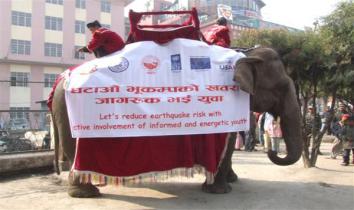Earthquake Safety Day

Earthquakes are an unavoidable part of Nepal's future, just as they have been a part of its past as Nepal lies in a very active seismic zone. Nepal has experienced a number of devastating earthquakes within living memory such as those in 1934 and 1998. In the 1934 earthquake more than eight thousand people lost their lives with massive destruction of property. The 1988 earthquake claimed 721 lives, mostly in the Eastern Nepal, and property worth millions of rupees were destroyed. The seismic record of Nepal suggests that earthquakes similar in size to the 1934 event occur approximately every 75 years, indicating that a devastating earthquake is inevitable in the long run and likely in the near future. It is thus very important and essential to create awareness among the people as well as the policy makers about the consequence of such disasters so that steps can be taken to mitigate the impact of such disasters in time. Keeping this reality in mind, Government of Nepal at NSET's request declared second day of the month of Magh as National Earthquake Safety Day (ESD), annually in commemoration of the Great Bihar-Nepal Earthquake of 1934. Apart from creating awareness about earthquakes the theme of the day is to share knowledge and information about safety measures and disaster management.
So every year on 2nd of Magh Nepal celebrates the national Earthquake Safety Day (ESD). It is in fact the culmination of earthquake risk management works implemented in the country in the preceding 12 months, and allows taking stock of the achievements and shortcomings.
The National Society for Earthquake Technology - Nepal (NSET) observes the ESD by organizing activities with the purpose of raising awareness on earthquake risk reduction and preparedness. NSET manages its ESD programs as a part of the national program, approved by the Earthquake Safety Day National Committee (ESDNC), chaired by Hon. Minister for Home Affairs.
NSET has successfully organized nine Earthquake Safety Days since 1999 with close cooperation with government organizations, municipalities, I/NGOs and local community. With invitation from NSET, participation from International level in ESD activities has also been very remarkable.
The ESD program typically runs for a week, and it includes;
- Ceremonial parts (National meetings with Honourable Prime Minister/ Minister as the Chief Guest
- Public broadcast of earthquake safety message by the Prime Minister/ Minister
- Earthquake Awareness rallies
- Publications and distribution of posters and other awareness materials
- Symposium on Experiences of Earthquake Risk Management
- Earthquake Awareness Exhibition that runs for 4-5 days
- Various programs for school children (essay/painting competition, street drama on earthquake safety etc)
- Demonstration of Shake Table test of 1:10 scale building models with and without earthquake-resistant elements
- Demonstration of Full Scale Model of Construction Details
- Demonstration on Fire Control and First Aid
Street drama














